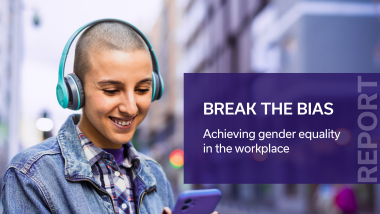How to uncover hidden bias in your hiring process
Every stage of the recruitment process can present opportunities for bias. From application to interview, women and minority candidates can encounter a multitude of obstacles, including ableism, ageism, homophobia, and sexism. These biases may be alienating promising talent from the outset, hindering your organisation’s equality, diversity, and inclusion (ED&I) efforts.
While our individual biases aren’t always apparent to us, we can teach ourselves to become more aware of them. Here are some ways gender bias can hide within your recruitment process, and how to tackle it in order to create a more inclusive experience for female candidates:
The time imbalance
When designing your recruitment process, it’s important to consider the existing time inequalities between men and women. Research shows working women currently spend an average of 15 hours a week more on unpaid domestic labour than men. If you’re inviting candidates to participate in a seven-stage recruitment process, this will likely have a more significant impact on a woman.
The burden of additional labour doesn’t just weigh on women at home. In the workplace, women are 48% more likely to volunteer for non-promotable tasks. These are jobs that benefit the organisation but won’t lead to promotion or contribute to the employee’s performance evaluation – such as organising parties, scheduling meetings, or taking notes. They are often administrative, time-consuming and offer little reward. Spending time on these tasks rather than higher value projects may hinder a woman’s career progression, as well as make it more difficult to invest time in her job search.
Solution
Companies that favour comprehensive, multi-stage hiring processes should consider offering greater flexibility around interviews and streamlining their process by reviewing the necessity of each component – including interviews, tasks, presentations and personality tests. A more flexible and refined process will help support women to balance the demands of their application with their current role and personal life.
The parent trap
Under the UK’s Equality Act 2010, it is illegal to ask a prospective employee whether they are married, have children or plan to have children in a job interview. Nonetheless, according to a 2018 study by YouGov, a third (36%) of U.K. private sector employers believe it’s appropriate to ask female candidates about their plans for children in the future.
Why are employers and hiring teams so eager to ask these questions? Unfortunately, many will use this information to make hiring decisions, typically based on concerns around maternity leave, potential absence from work in order to take care of their children, or the cost of adding children to the company’s health plan. However, a 2019 study by Barcelona’s Pompeu Fabra University found that female job applicants could face discrimination regardless of their family life. The research was conducted by distributing the fictitious resumes of “applicants” aged 37 to 39 for 1,372 real job adverts in Madrid and Barcelona. The roles in question were spread across 18 occupations with varied degrees of feminisation, essential qualifications and responsibilities.
The study’s findings demonstrate the double bind that women can experience in the recruitment process: those without children were 23.5% less likely to be invited to interview than men who shared the same circumstances. However, mothers were 35.9% less likely to be called for a job interview than fathers.
Solution
These types of questions discriminate against female talent and are irrelevant to a person’s ability to perform in a role. It’s up to individual organisations, employers and hiring managers to commit to phasing them out. However, your recruitment process may include several other interview questions that can potentially discriminate against certain candidates. The best way to challenge these biases is to examine every stage and candidate touchpoint. An end-to-end audit can help companies hold a mirror up to their processes and understand what they’re doing right, and where there might be room for improvement.
Resource Solutions’s comprehensive inclusivity audit analyses the impact of recruitment processes through seven different Diversity & Inclusion lenses – including Gender, Ethnicity, Disability & Neurodiversity, LGBTQ+, Age, Socio-Economic and Faith – across 12 stages of the candidate journey. Clients are provided with an immediate ‘to do’ list to help them effect meaningful change, and key findings are ready within 30 working days. These recommendations vary, but they can include banning direct questions about a candidate’s salary, or inclusive language optimisation to make job adverts more accessible to a wider pool of talent.
The pay gap cycle
Asking a candidate about their previous salary during the recruitment process is a common practice, but using this figure determine their potential new salary can help perpetuate the pay inequality cycle. As women statistically earn less than men – the current gender pay gaps stand at 15.5% in the U.K. and around 16% in the U.S. – this question can immediately put a female applicant in a lower earning bracket than a male applicant for the same role. It also penalises individuals who have taken a career break, been in part-time work or moved to an area with higher living costs. According to a survey by UK campaign group The Fawcett Society, 58% of women and 54% of men believe salary history questions lead to a lower wage than they might otherwise have been paid.
Salary negotiations also present potential for gender bias within internal hiring scenarios. In a 2021 study analysing data from 2,500 salary negotiators, Harvard Business School Professor Julian Zlatev found that the higher a woman rises through a company’s ranks, the more backlash she faces if she negotiates her salary assertively.
Solution
The risk of gender bias in salary negotiations scenarios is clear and alarming, but companies such as Buffer are taking promising steps to erase it completely. In 2013, the social media content platform published its payment formulas online for the world to see, and in 2021, Buffer credited this transparency as the main reason they were able to cut their gender pay gap down to 5.5% from 15% in 2020. Rather than attempting to fix the individual, employers must recognise the actual barriers facing women in order to address inequalities and achieve tangible results.
Across the U.S., state and local governments are increasingly adopting laws and regulations that prohibit employers from requesting salary history information from job applicants. At the time of writing, there are 21 state-wide bans. Some of these laws go beyond merely banning pay history questions – a few also prohibit an employer from relying on an applicant's pay history to set compensation if discovered or volunteered, while others prohibit an employer from taking disciplinary action against employees who discuss pay with co-workers.
Download our whitepaper, Break the Bias: Achieving gender equality in the workplace, for further insights into gender equality and how hidden bias within your recruitment process could be alienating diverse talent. In addition, you’ll discover actionable tips for fostering a more inclusive company culture.













